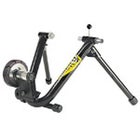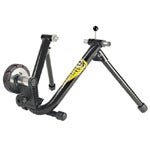That’s not a bad idea. Riding an indoor bike trainer will help tons with flexibility, build strength, and help maintain cardio fitness, while only mildly stressing the repaired ligament.

First thing I recommend, though, is a radio or TV located where you plan to work out. I find riding an indoor trainer insanely boring, and must have something like NPR’s “Talk of the Nation” or a baseball game to distract me. Music doesn’t cut it.
As for the trainers, wind-resistance models are the least expensive and simplest of your options, and have the further advantage of mimicking real road conditions (the faster you go and the higher the gear, the more drag the fan puts on things). But, they’re noisy as hell. CycleOps makes a wind trainer called simply the Wind Bicycle Trainer, selling for $160 (www.cycleops.com).
Magnetic and fluid-resistance models are much quieter and work very well too. I’ve been using a fluid-resistance model for four or five years and have been very happy with it. Not quite the resistance of my earlier fan-based one, but virtually silent.
My trainer is an older model from Performance that is a “full-frame” trainer. That is, it’s the same length as the bike, and to use it you remove the front wheel and attach the dropouts to the front of the trainer. These days, though, rear-wheel trainers are far more common. The front wheel can be left alone, or stuck in a little floor chock ($10 for most models). One example of a modern magnetic-resistance trainer is the CycleOps Magneto 9004 Trainer ($230). The magnets in the flywheel are set up so that they move as you spin the wheel, adding resistance as you go faster. It folds up for easy storage, too. Blackburn makes a slightly less exotic mag trainer called the Trakstand, selling for $159 (www.rei.com).
In a fluid-resistance trainer, TravelTrac makes one called the Century ($170; www.performancebike.com). About the same price as the Blackburn, but with more realistic resistance.
Another great accessory for indoor training is a heart-rate monitor. Rather than just sitting and spinning, you can use the gadget to vary your workout. I like to warm up for five minutes, then push the heart rate to 140 or so for five minutes, then do some sprints, then try to hold the heart at 150 for five minutes, before finishing with a couple of hard-as-I-can-go pushes. Just around the half-hour mark, that’s enough for me. Even with NPR.


